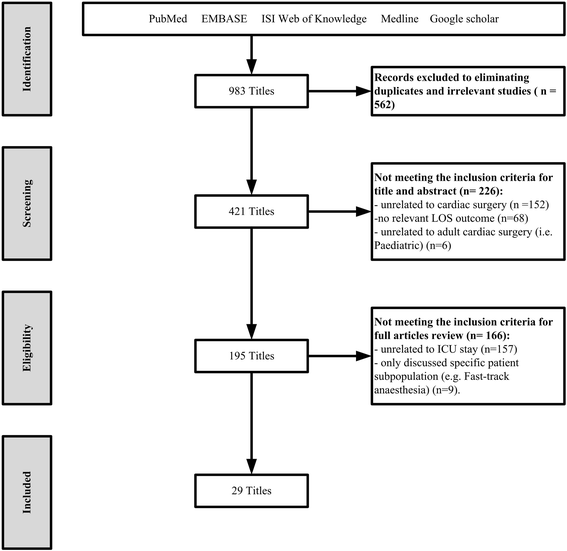Systematic review of factors influencing length of stay in ICU after adult cardiac surgery
- PMID: 27473872
- PMCID: PMC4966741
- DOI: 10.1186/s12913-016-1591-3
Systematic review of factors influencing length of stay in ICU after adult cardiac surgery
Abstract
Background: Intensive care unit (ICU) care is associated with costly and often scarce resources. In many parts of the world, ICUs are being perceived as major bottlenecks limiting downstream services such as operating theatres. There are many clinical, surgical and contextual factors that influence length of stay. Knowing these factors can facilitate resource planning. However, the extent at which this knowledge is put into practice remains unclear. The aim of this systematic review was to identify factors that impact the duration of ICU stay after cardiac surgery and to explore evidence on the link between understanding these factors and patient and resource management.
Methods: We conducted electronic searches of Embase, PubMed, ISI Web of Knowledge, Medline and Google Scholar, and reference lists for eligible studies.
Results: Twenty-nine papers fulfilled inclusion criteria. We recognised two types of objectives for identifying influential factors of ICU length of stay (LOS) among the reviewed studies. These were general descriptions of predictors and prediction of prolonged ICU stay through statistical models. Among studies with prediction models, only two studies have reported their implementation. Factors most commonly associated with increased ICU LOS included increased age, atrial fibrillation/ arrhythmia, chronic obstructive pulmonary disease (COPD), low ejection fraction, renal failure/ dysfunction and non-elective surgery status.
Conclusion: Cardiac ICUs are major bottlenecks in many hospitals around the world. Efforts to optimise resources should be linked to patient and surgical characteristics. More research is needed to integrate patient and surgical factors into ICU resource planning.
Keywords: Cardiac ICU resource utilisation; Cardiac surgery; Length of stay.
Figures
References
-
- Green LV. How many hospital beds? INQUIRY. 2002;39(4):400–12. - PubMed
-
- Stephens RS, Whitman GJ. Postoperative Critical Care of the Adult Cardiac Surgical Patient. Part I: Routine Postoperative Care. Crit Care Med. 2015;43(7):1477-97. Epub 2015/05/12. - PubMed
-
- Narin C. Special Topics in Cardiac Surgery. Croatia: InTech; 2012. Available from: http://www.intechopen.com/books/special-topics-in-cardiac-surgery. Accessed 8 Dec 2015.
Publication types
MeSH terms
LinkOut - more resources
Full Text Sources
Other Literature Sources
Medical


